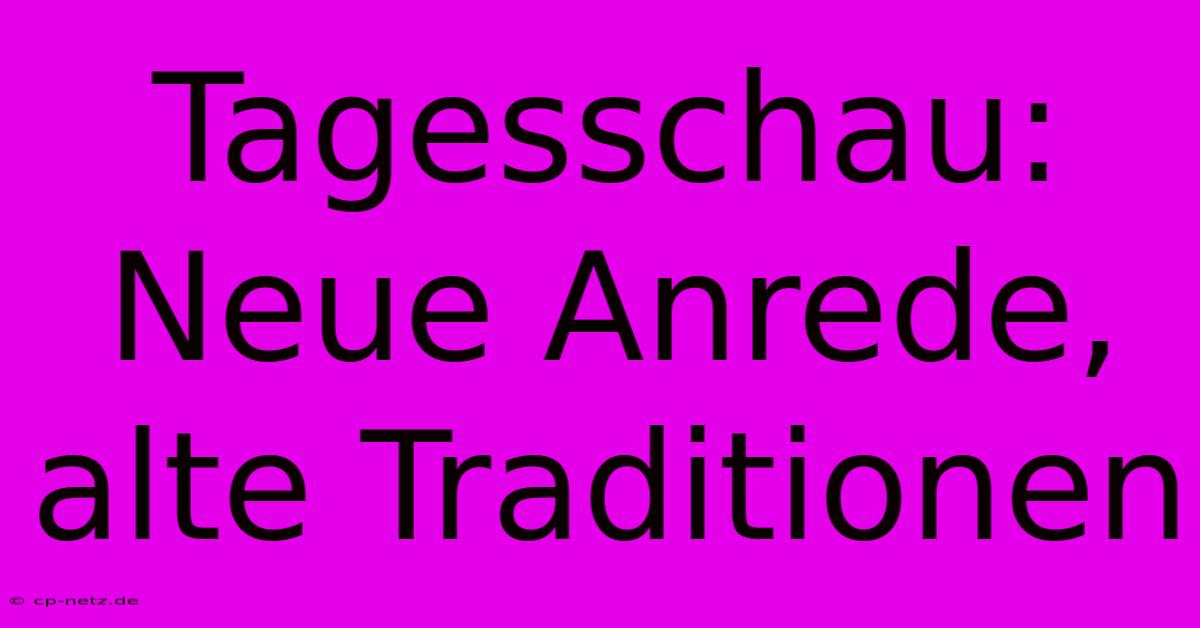Tagesschau: Neue Anrede, Alte Traditionen

Discover more detailed and exciting information on our website. Click the link below to start your adventure: Visit Best Website Tagesschau: Neue Anrede, Alte Traditionen. Don't miss out!
Table of Contents
Tagesschau: Neue Anrede, alte Traditionen – Ein Blick hinter die Kulissen
Hey Leute! Let's talk about the Tagesschau, Germany's iconic news broadcast. You know, the one your Oma watches religiously? Yeah, that one. Lately, there's been a bit of a buzz – a change in how the news anchors address the viewers. It’s not a massive overhaul, but it's enough to get people talking, right? And as someone who's obsessed with media and communications (yes, really!), I wanted to dive in.
Von "Guten Abend" zu "Guten Abend, meine Damen und Herren" – Ein kleiner, aber feiner Unterschied
Remember when the Tagesschau anchors used to just say "Guten Abend"? Simple, classic, right? Well, now it's often "Guten Abend, meine Damen und Herren." Seems minor, almost insignificant, but it's sparked a pretty interesting debate. Some people think it's a bit old-fashioned, even stuffy. Others see it as a nod to tradition, a way to maintain a certain level of formality. I mean, I get it – the Tagesschau is a pretty serious affair. It’s not like watching some silly YouTube video; it's the news! It needs that air of professionalism.
Personally, I was initially a bit taken aback. It felt… slightly awkward? I mean, I’m used to a more informal way of speaking in the media these days. But then I thought about it. The Tagesschau has been around for ages – I mean, ages – and its style has always been quite formal. Maybe this slight tweak is just a reminder of that legacy. It's kind of like finding an old photo album – it reminds you of where things came from.
Tradition und Moderne: Ein Balanceakt
This whole "Anrede" thing (addressing the viewers) highlights a bigger issue facing the Tagesschau and other news outlets: balancing tradition with modern sensibilities. How do you stay relevant to a younger audience, many of whom might find the traditional format a bit… boring? At the same time, how do you keep the integrity of a news program with such a long and established history?
I've read a few articles about this – and let me tell you, finding information on this specific topic in English is tricky. Most of the discussion is happening in German, which is understandable, considering the Tagesschau is a German institution. But the underlying question is universal. How does any media adapt to modern audiences without alienating their loyal fanbase?
One thing's for sure: the Tagesschau's viewer demographics are changing. The older generations are accustomed to the formal style; but younger viewers might prefer a more casual, informal presentation. Finding that sweet spot is key to long-term success. It’s a tricky balancing act, indeed. Maybe they should experiment with slightly different styles on their online presence, and maybe offer the option to listen to podcasts too? Just a thought…
Die Zukunft der Tagesschau: Innovation und Respekt vor der Geschichte
Looking ahead, I think the Tagesschau will continue to navigate this delicate balance. They’ll likely experiment with different approaches, trying to maintain their traditional formality while engaging a wider audience. Maybe we'll see more use of social media, or perhaps even interactive elements integrated into the broadcasts themselves. Innovation is necessary, but so is respect for the history and legacy of this esteemed news institution.
It’s not just about the "Guten Abend"; it's about the overall image and approach. This is a big deal. This small change shows they're actively thinking about the future and trying to engage with the times, even if it is a tiny change. And honestly, that's kind of cool.
So yeah, that’s my two cents on the Tagesschau's new (ish) address. What are your thoughts? Let’s chat in the comments! Let me know what you think of the change. Maybe I’m completely off base. I'd love to hear your perspective!

Thank you for visiting our website wich cover about Tagesschau: Neue Anrede, Alte Traditionen. We hope the information provided has been useful to you. Feel free to contact us if you have any questions or need further assistance. See you next time and dont miss to bookmark.
Featured Posts
-
Frauen Em Dfb Dominiert Gastgeber
Nov 30, 2024
-
Formel 1 Saisonende Naht Entscheidung Faellt
Nov 30, 2024
-
Puccinis Erbe Nach 100 Jahren
Nov 30, 2024
-
Semmering Tunnel Nach 10 Jahren Fertig
Nov 30, 2024
-
Formel 1 In Monza Bis 2031
Nov 30, 2024
